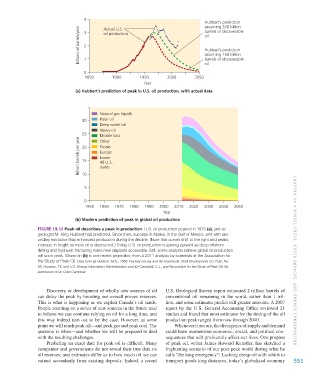Page 552 - Environment: The Science Behind the Stories
P. 552
4
Hubbert’s prediction
assuming 200 billion
Billions of barrels/year 2 oil
Actual U.S.
barrels of discoverable
3
oil production
Hubbert’s prediction
assuming 150 billion
1
oil
0 barrels of discoverable
1850 1900 1950 2000 2050
Year
(a) Hubbert’s prediction of peak in U.S. oil production, with actual data
Natural gas liquids
30 Polar oil
Deep-water oil
Heavy oil
25 Middle East
Billion barrels per year 20 Russia
Other
Europe
Lower
15
48 U.S.
states
10
5
0
1950 1960 1970 1980 1990 2000 2010 2020 2030 2040 2050
Year
(b) Modern prediction of peak in global oil production
FIGURE 19.12 Peak oil describes a peak in production. U.S. oil production peaked in 1970 (a), just as
geologist M. King Hubbert had predicted. Since then, success in Alaska, in the Gulf of Mexico, and with sec-
ondary extraction has enhanced production during the decline. (Note that curves shift to the right and peaks
increase in height as more oil is discovered.) Today U.S. oil production is spiking upward as deep offshore
drilling and hydraulic fracturing make new deposits accessible. Still, some analysts believe global oil production
will soon peak. Shown in (b) is one recent projection, from a 2011 analysis by scientists at the Association for
the Study of Peak Oil. Data from (a) Hubbert, M.K., 1956. Nuclear energy and the fossil fuels. Shell Development Co. Publ. No. CHAPTER 19 • FOSSIL FUELS, THEIR IMPA CT S, AND ENERGY CONSERVATI ON
95, Houston, TX; and U.S. Energy Information Administration; and (b) Campbell, C.J., and Association for the Study of Peak Oil. By
permission of Dr. Colin Campbell.
Discovery or development of wholly new sources of oil U.S. Geological Survey report estimated 2 trillion barrels of
can delay the peak by boosting our overall proven reserves. conventional oil remaining in the world, rather than 1 tril-
This is what is happening as we exploit Canada’s oil sands. lion, and some estimates predict still greater amounts. A 2007
People counting on a series of new sources in the future tend report by the U.S. General Accounting Office reviewed 21
to believe we can continue relying on oil for a long time, and studies and found that most estimates for the timing of the oil
this may indeed turn out to be the case. However, at some production peak ranged from now through 2040.
point we will reach peak oil—and peak gas and peak coal. The Whenever it occurs, the divergence of supply and demand
question is when—and whether we will be prepared to deal could have momentous economic, social, and political con-
with the resulting challenges. sequences that will profoundly affect our lives. One prophet
Predicting an exact date for peak oil is difficult. Many of peak oil, writer James Howard Kunstler, has sketched a
companies and governments do not reveal their true data on frightening scenario of our post-peak world during what he
oil reserves, and estimates differ as to how much oil we can calls “the long emergency”: Lacking cheap oil with which to
extract secondarily from existing deposits. Indeed, a recent transport goods long distances, today’s globalized economy 551
M19_WITH7428_05_SE_C19.indd 551 12/12/14 5:23 PM

